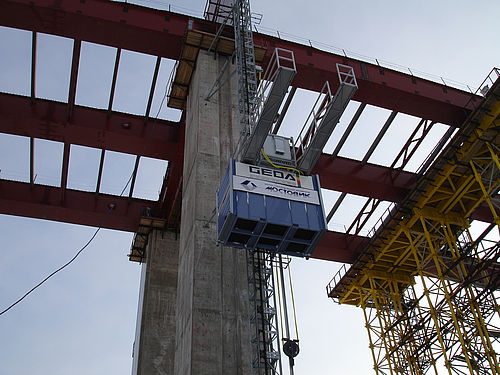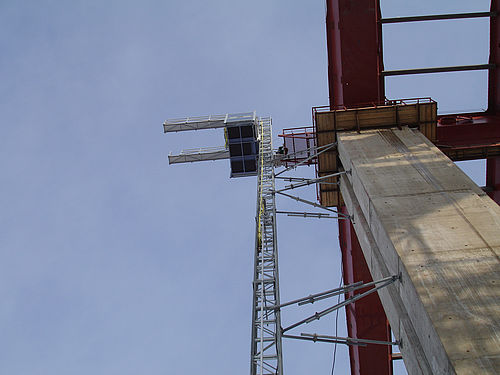Mega project worth billions in Vladivostok
- Bridges between Asia and Europe -


Two large bridges are to be built in the Russian port of Vladivostok by the time of the Asia-Pacific Summit (APEC) in 2012: A four-lane suspension bridge on 226 metre high pylons will initially span the five kilometre long bay area, Golden Horn. Another bridge (320 m) will continue the route over a strait called the "Eastern Bosporus" to the offshore island of Russki where the conference will take place. The plan is to build an entirely new district on the island which was once declared a restricted area by the military.
This mega project is Russia's largest building site. 6.5 billion Euros are being invested in this prestigious construction project. The significance of the project for Russia is highlighted by regular flying visits by the Russian Prime Minister Vladimir Putin himself.
Building work began on the so-called Russki Bridge in September 2008. The 1885 m long suspension bridge is supported by two 320 m high pylons and creates a connection to the new Russki Island district. A tight schedule and the upcoming APEC summit mean there is huge pressure on all the companies participating in this pre-eminent building project. The German company GEDA-Dechentreiter GmbH & Co.KG from Bavaria was awarded the contract for supplying the vertical access technology. GEDA has become an integral partner in the construction hoist industry over the last few decades and has recently expanded its product range with large-scale hoists. To start with, four personnel and material hoists, type GEDA PH2032, were ordered for the Vladivostok project; two of which have already been in use since last year; the next two units will be supplied shortly. The hoists "grow" with the pylons in line with construction up to a height of 320 m. These hoists achieve frequency converter controlled lifting speeds of 65 m/min, a lifting height of up to 400 m and are licensed for transporting 25 people or 2 tonnes.
The hoist cars are loaded and unloaded at the platforms of the telescoping formwork by an additional exit, a so-called D-door on the inside of the car. Specially designed 4.5 m long anchors ensure the necessary distance to the pylons. They are anchored from two adjustable assembly bridges that are mounted on the roof. Naturally the fact that the pylons incline more and more as they get higher had to be considered in the planning. The base unit of the devices and mast elements are therefore prepared to compensate for the necessary incline and to adjust to the altered pylon geometry as the construction height grows. In addition to this, the hoists had to be adapted to the severely critical climate conditions in Vladivostok, such as heavy snowfall and icy temperatures.
The prescribed safety directives and special designs for this project have been accepted and confirmed by the Russian authorities. The safety at entry and exit points is ensured by GEDA landing gates which meet all requirements set by the latest European Machinery Directive 2006/42/EC. Different landing gates from the extensive GEDA range are being used to address various instructions and preconditions. Needless to say, safety features such as the speed-dependent GEDA overspeed safety device and overload protection, as well as limit switches at the top and bottom levels, are part of the standard package.
Vladivostok is the most important Russian port on the Pacific. As the final stop on the Transsiberian railway, it has only been accessible again to foreigners since 1991. Today, nearly 600,000 people live in Vladivostok and the city has become a significant industrial and economic centre as well as a regional traffic and transit hub due to the port. Constructing these bridges forms yet another important milestone in the history of European and Asian relations.




 Download as PDF
Download as PDF Print page
Print page